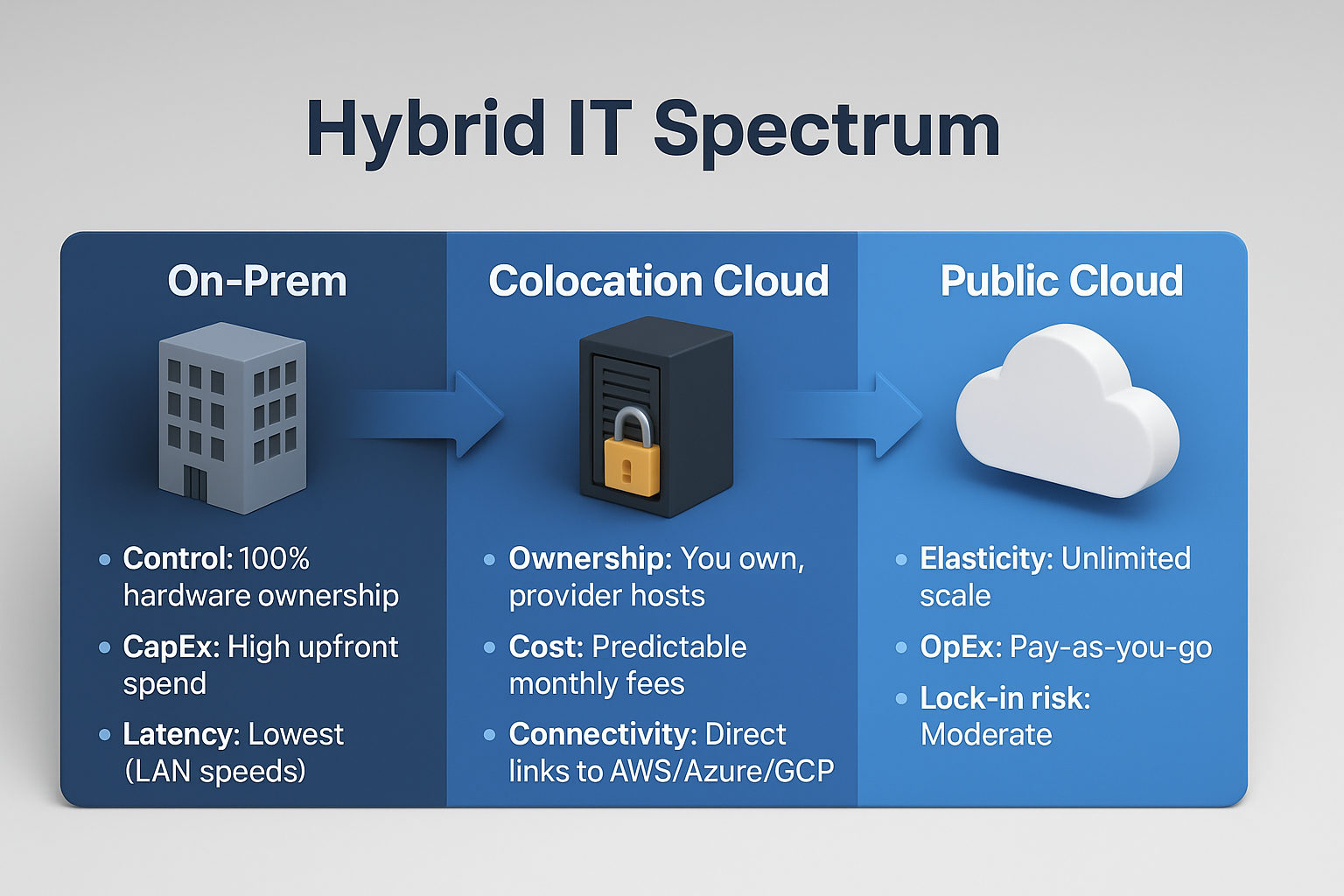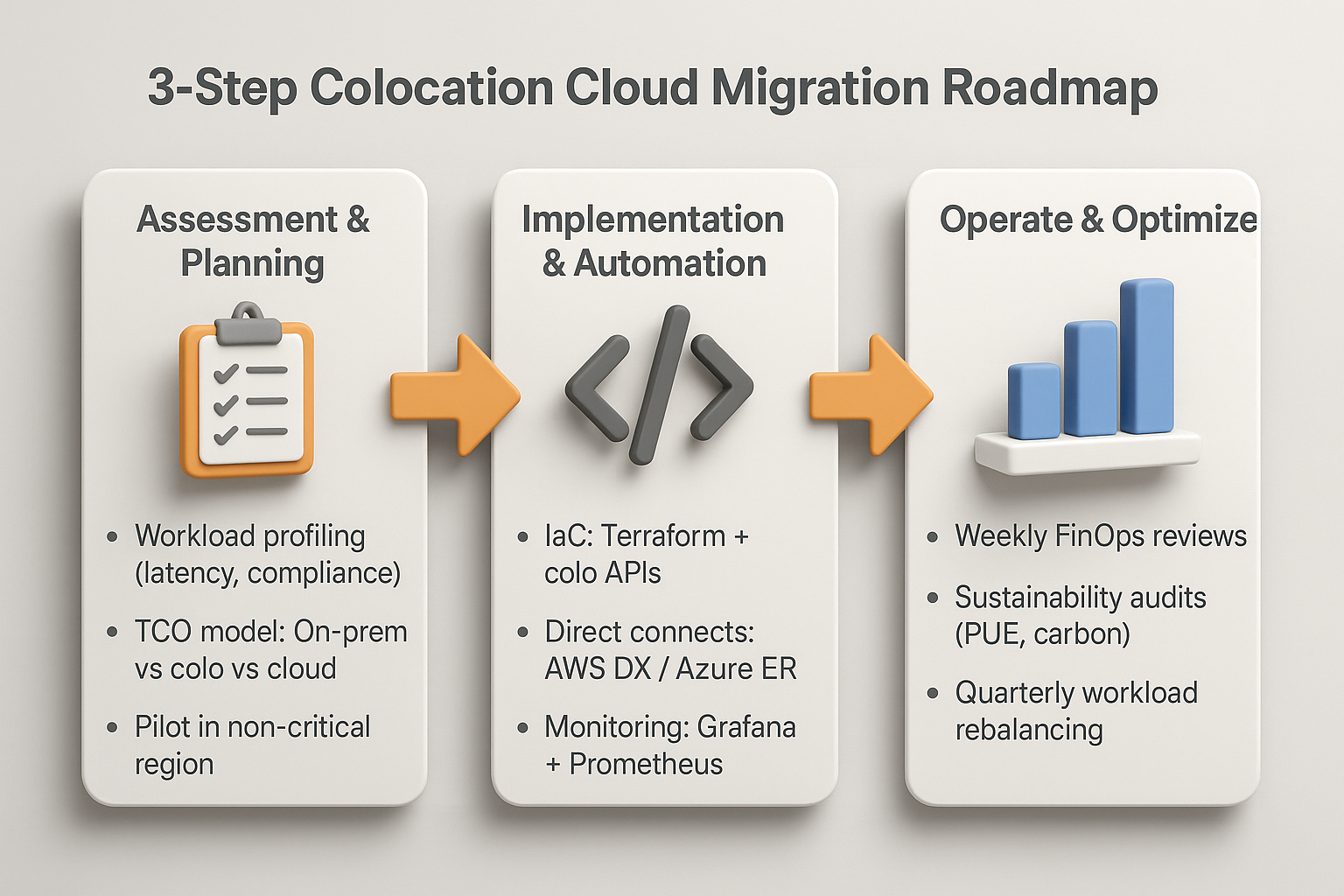Your on-prem data center is creaking under ever-growing workloads. Public cloud bills keep spiking, and you’re stuck between expensive CapEx hardware upgrades and runaway OpEx.
Imagine deploying an AI model, only to wait weeks for GPU capacity in the cloud. Or facing network bottlenecks when your branch offices need low-latency access. The stress, the budget overruns, the missed deadlines—it all adds up.
Enter the colocation cloud. It’s the sweet spot that blends on-prem control with cloud-like flexibility. In this guide, you’ll learn how colocation cloud computing slashes costs, boosts performance, and future-proofs your IT in 2025. Ready to bridge the gap? Let’s dive in.
Introduction to Colocation Cloud
Colocation cloud is a hybrid IT model where you own and manage your servers, but host them in third-party data centers equipped with direct links to major public clouds. In other words, you get the best of both worlds: on-prem security and cloud-native agility.
Key Benefits:
- Control & Ownership: You pick your hardware specs and manage firmware.
- Elastic Connectivity: Connect over private circuits to AWS, Azure, or GCP.
- Cost Transparency: Fixed monthly fees for space, power, and network.
By choosing colocation cloud hosting, enterprises avoid vendor lock-in and unpredictable cloud bills while gaining access to world-class data center environments.
Why Colocation Cloud Matters in 2025
As we approach mid-decade, hybrid deployments are no longer optional—they’re essential. From soaring AI demands to edge-driven latency requirements, firms need infrastructure that scales on their terms.
Market Overview & Growth Forecasts
- Cloud Spending Explosion: Global cloud compute spending is set to exceed $1.3 trillion by 2025, driven by digital transformation initiatives.
- Colocation on the Rise: Gartner forecasts that 20% of new enterprise workloads will be placed in colocation facilities by next year.
- Hybrid Budget Shifts: CFOs are reallocating 15–25% of pure public cloud budgets into hybrid and colocation cloud services for cost predictability and control.
Pro Tip: When planning budgets, include both rack space fees and cross-connect costs to get a true picture of monthly spend.
Key Drivers: AI, Edge, Quantum
AI & HPC Demands
- Training large language models requires sustained GPU throughput. Public clouds face capacity caps, leading to long wait times. By building GPU clusters in a colocation cloud, you unlock dedicated performance and reduce queue time.
Edge Computing Growth
- Applications like AR/VR, IoT analytics, and real-time monitoring demand sub-10 ms latency. Colocating micro data centers near end-users ensures fast response while keeping backbone costs low.
Quantum Preparations
- Early adopters are placing quantum-readiness labs in neutral colocation sites. You can host specialized quantum hardware alongside classical servers, ready to plug into enterprise networks when quantum hits production.
Why It Matters: As workloads diversify, rigid on-prem setups and unpredictable public clouds both fall short. Hybrid colocation cloud services fill the gap.
Hybrid Cloud Integration: The Ultimate Guide for Businesses | Reboot Monkey
Core Architecture & Deployment Models

Enterprises now choose among four main models: on-premises, public cloud, hybrid cloud, or colocation cloud. Understanding each helps you pick the right mix.
On-Prem vs Colocation vs Public Cloud
| Feature | On-Prem | Public Cloud | Colocation Cloud Hosting |
| Hardware Ownership | You own & manage | Provider owns & manages | You own, provider hosts |
| Scalability | Limited by capacity | Virtually unlimited | Medium—add racks as needed |
| Cost Structure | High CapEx upfront | OpEx—pay as you go | Moderate CapEx + fixed Opex |
| Network Latency | Low within LAN | Variable Internet latency | Low—private interconnects |
| Compliance Control | Full control | Shared responsibility | Full control + data residency |
Verdict: If you need hardware choice and direct cloud links without massive CapEx, colocation cloud is the optimal middle path.
Hybrid & Multi-Cloud with Colocation
By deploying racks in colocation centers that offer native support for multiple public clouds, you can:
- Unify Management: Use tools like VMware HCX or Cisco Intersight to orchestrate workloads across on-prem, colo, and cloud.
- Optimize Workloads: Run bursty workloads in cloud regions, steady-state services in colo racks, and proprietary apps on-prem.
- Reduce Egress Fees: Keep bulk data in your colo footprint, and only move processed or cleansed data to public clouds.
Emerging Use Cases & Workloads
What workloads make the best candidates for colocation cloud computing? Let’s explore.
AI & HPC Workloads
- Training Clusters: Colocated GPU pods reduce training iterations from days to hours.
- Inference at Scale: Deploy inference appliances close to end-users—ideal for real-time recommendations and computer vision.
- Data Proximity: Host large datasets in colo, minimizing the cost of moving terabytes back and forth to public clouds.
Example: A media company trains its video-analysis AI models in a Frankfurt colocation site, cutting data transfer costs by 60%.
Edge, 5G & Sovereign Cloud
- Retail Edge: Install micro-racks in regional colos for sub-5 ms POS transaction processing.
- Industrial IoT: Connect factory sensors via private 5G radios directly into colo racks, bypassing the public Internet.
- Sovereign Requirements: Use local colocation facilities certified for data residency to meet GDPR, HIPAA, or other regulations.
Key Point: By combining colocation cloud services with edge and sovereign strategies, organizations can deliver low-latency, compliant applications globally.
Contact us today to get a hands-on migration roadmap tailored to your hybrid colocation cloud computing needs.
Infrastructure Innovations
Modern colos aren’t your grandpa’s server rooms—they’re innovation hubs.
Immersion & Liquid Cooling
High-density GPU and CPU clusters generate massive heat. Leading colocation cloud services now offer:
- Immersion Cooling Tanks: Servers submerged in dielectric fluid, achieving Power Usage Effectiveness (PUE) as low as 1.05.
- Rear-Door Heat Exchangers: Capture waste heat, cooling airflow more efficiently than traditional chillers.
Benefit: Lower cooling costs, higher rack densities, and a smaller environmental footprint.
Sustainable & Green Operations
- Renewable Energy Contracts: Wind and solar PPAs power 80–100% of facility consumption.
- Heat Reuse Programs: Redirect server heat into neighboring buildings for district heating.
- Carbon Reporting: Integration with FinOps dashboards to track both cost and carbon emissions under a unified colocation cloud management platform.
FinOps Insight: Align sustainability metrics with cost metrics to drive eco-friendly decisions that also save money.
Colocation Data Center Services: Reliable Hosting for You
Management & Connectivity
Smooth operations hinge on robust management tools and high-speed connectivity.
Colocation Cloud Management Platforms
These platforms provide:
- Real-Time Monitoring: Track power draw, temperature, and rack density via APIs.
- Automation: Provision new servers, VLANs, and cross-connects with IaC tools like Terraform.
- FinOps Integration: Leverage the FOCUS spec to unify financial and operational data in dashboards.
Popular Options: Equinix Metal, Digital Realty ServiceFabric, CyrusOne CommandCenter.
Cloud Interconnect & Hybrid Networking
- Direct Connects: Private circuits to AWS Direct Connect, Azure ExpressRoute, and Google Cloud Interconnect.
- SDN Overlays: Use software-defined networking to span your on-prem, colo, and multi-cloud environments seamlessly.
- Low-Latency Backbone: Benefit from fiber rings with end-to-end latencies under 1 ms in metro regions.
Tip: Negotiate bundled bandwidth packages—many providers offer volume discounts on high-speed ports.
Security, Compliance & Sovereignty
Physical and digital security converge in colocation cloud environments.
Physical & Network Security
- 24/7 Security Staff & Biometric Access: Ensure only authorized individuals can enter secure cages and cabinets.
- CCTV & Patrols: Continuous video surveillance and routine patrols.
- Encrypted Dark Fiber: Private, end-to-end encryption over fiber circuits eliminates public Internet exposure.
Outcome: A hardened perimeter that complements your cloud-native security controls.
Governance: DORA, GDPR, Sovereign Cloud
- Regulatory Compliance: Data centers hold ISO 27001, SOC 2, PCI DSS, and local certifications needed for finance and healthcare industries.
- DORA & GDPR: Colocating in-region facilities helps meet the EU’s Digital Operational Resilience Act and GDPR data residency mandates.
- Audit Readiness: Detailed logs and physical access records simplify compliance audits.
Insider Advice: Maintain your configuration management database (CMDB) to track where each workload resides—colo or cloud.
Top Benefits of Colocation Data Centers for Businesses in 2025 | Reboot Monkey
Cost & FinOps Impacts
Hybrid budgets can spiral if unmanaged. Colocation cloud services paint a clearer financial picture.
Cost Comparison: On-Prem vs Public vs Colocation
| Cost Element | On-Prem | Public Cloud | Colocation Cloud Services |
| Hardware | High CapEx | N/A | Moderate CapEx |
| Power & Cooling | In-House Opex | Included in fees | Fixed Opex |
| Network | ISP contracts | Variable egress fees | Private cross-connect fees |
| Management | In-house staff | Shared responsibility | Mix of in-house & APIs |
| Total Cost Model | Lumpy, unpredictable | Pay-as-you-go | Predictable monthly bills |
FinOps Maturity in Hybrid Environments
- Visibility: Tag resources by cost center—on-prem, colo, cloud—for granular spend reports.
- Optimization: Use rightsizing tools to shift static workloads into colo and bursty jobs into the cloud.
- Governance: Establish budget guardrails and automated alerts for cost overruns.
Ready to tame your hybrid cloud spend? Reach out for a free FinOps assessment and see how colocation cloud management can transform your budget.
Vendor Landscape & Selection Criteria
Choosing the right colocation cloud company makes or breaks your hybrid strategy.
Leading Colocation Cloud Companies in 2025
- Equinix Metal: Global footprint, on-demand hardware with API control.
- Digital Realty: ServiceFabric unifies colo and cloud orchestration.
- CyrusOne: High-density, green-certified campuses in key metros.
- Iron Mountain: Ultra-secure, compliance-focused sites for regulated sectors.
Insider Tip: Compare SLAs not just on uptime, but on provisioning speed and support response times.
Selection Checklist
- SLAs & Uptime Guarantees: ≥ 99.99% with transparent credits.
- Power Density & Redundancy: Minimum N+1 for generators and cooling.
- Connectivity Options: Multiple carriers, direct cloud interconnects.
- Compliance Certifications: ISO 27001, SOC 2, PCI DSS, GDPR readiness.
- Sustainability Credentials: LEED, BREEAM, renewable energy use.
Hybrid Cloud Solutions: The Perfect Balance for Modern Organizations | Reboot Monkey
Migration & Adoption Strategies

A phased approach ensures a smooth transition to a hybrid colo-cloud setup.
Assessment & Planning
- Workload Profiling: Classify apps by latency sensitivity, throughput, and compliance.
- TCO Modeling: Compare CapEx vs OpEx across on-prem, cloud, and colo.
- Pilot Programs: Start with noncritical workloads to validate connectivity and performance.
Implementation & Orchestration
- Infrastructure as Code: Use Terraform modules for colo APIs to spin up racks, VLANs, and cloud circuits.
- Automation Pipelines: Integrate Jenkins or GitLab CI for automated deployment workflows.
- Unified Monitoring: Centralize logs with Splunk or ELK stacks fed by both colo and cloud agents.
Operations & Continuous Optimization
- Weekly FinOps Reviews: Analyze spend anomalies and right-size resources.
- Quarterly Sustainability Audits: Measure PUE, carbon footprint, and integrate procurement insights.
- DevOps Collaboration: Keep dev, sec, and ops aligned by merging colo tickets into the same workflow tools you use for cloud.
Real-World Case Studies
Enterprise AI Training at a London Colocation Site
A financial services firm moved its GPU clusters to a London colocation cloud provider. Results:
- 30% faster model training.
- 40% reduction in egress and compute costs.
- Zero queue times for GPU jobs.
Edge Retail IoT Deployment in Berlin
A retail chain deployed micro-colo units in Berlin and Munich for POS and inventory analytics. Outcomes:
- Sub-5 ms transaction latency.
- 99.99% availability during peak shopping hours.
- Complied fully with EU GDPR and DORA requirements.
Future Outlook & Emerging Innovations
The horizon for colocation cloud computing is bright, with new trends on the verge of mainstream adoption.
Quantum & Neuromorphic on Prem + Colocation
- Quantum Testbeds: Colocating quantum hardware near high-bandwidth classical servers to reduce noise and latency.
- Neuromorphic Chips: Hosting specialized AI accelerators for real-time sensory processing in industrial settings.
AI-Optimized Edge-Cloud Continuum
- ECCC Convergence: The Edge-Cloud Continuum concept couples 6G networks, AI model placement, and colo micro data centers for seamless compute.
- Dynamic Orchestration: Automated systems that move workloads between edge, colo, and cloud based on real-time metrics.
Download our free Vendor Comparison Matrix to shortlist the best colocation cloud service providers for your needs.
Final Words
In summary, the colocation cloud combines the best of on-prem control and public cloud agility—delivering predictable costs, high performance, and robust security. By choosing colocation cloud services, you can accelerate AI projects, power edge applications, and meet data-sovereignty requirements with ease. Evaluate providers on SLAs, connectivity, and sustainability, and integrate FinOps practices to continuously optimize spend and performance.
Frequently Asked Questions
What is colocation cloud, and how does it differ from traditional hosting?
Colocation cloud lets you own and manage your servers in a third-party data center, with direct links to public clouds. Unlike traditional hosting, you get full hardware control plus elastic cloud connectivity.
How can colocation cloud improve my application performance?
By colocating servers near major network hubs and using private cloud interconnects, colocation cloud reduces latency and delivers consistent throughput for demanding workloads.
Is colocation cloud secure enough for regulated industries?
Yes. Colocation cloud providers offer 24/7 physical security, biometric access controls, and certifications like ISO 27001 and SOC 2, ensuring compliance with regulations like GDPR and HIPAA.
What are the cost benefits of using colocation cloud?
With predictable monthly fees for space, power, and network, colocation cloud eliminates surprise cloud bills and balances CapEx ownership with OpEx flexibility.
How do I get started with a colocation cloud deployment?
Begin by assessing your workload needs—latency, throughput, compliance—then choose a provider with the right SLAs and connectivity options. Reach out for a tailored colocation cloud roadmap today!

